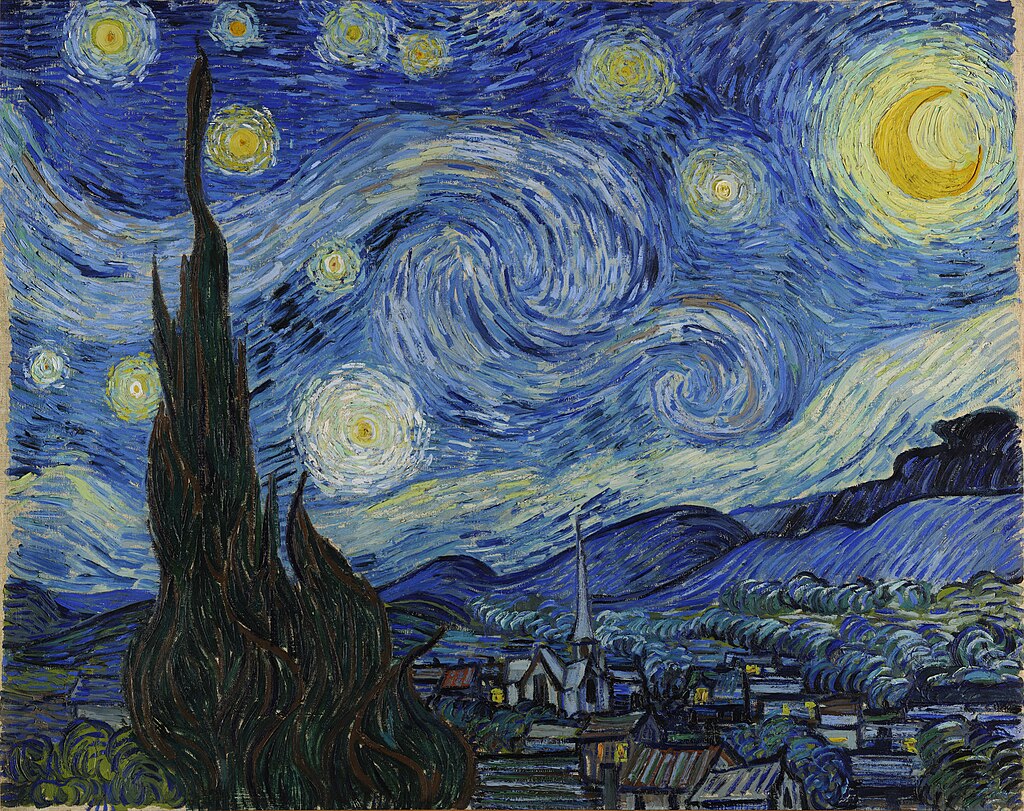
“It is looking at things for a long time that ripens you and gives you a deeper meaning.”
- Vincent Van Gogh -
When Modest Mussorgsky attended an exhibition of his friend Viktor Hartmann's artwork, he was so moved by the visual impressions that he sought to capture the mood of each piece through music. This inspiration led to the creation of Pictures at an Exhibition (tracks 1-5), a brilliant example of how art begets more art. Composed in just twenty days, the ten-movement piano suite represents various works by Hartmann, with recurring Promenade interludes (track 1,3, and 5) symbolising the act of strolling through the gallery. On your next walk through the National Gallery, channel Mussorgsky's vision and let the art guide you. You might be surprised by what you discover.
This year, the walls of the National Gallery are graced with the exquisite late works of Vincent van Gogh, who once said, “It is looking at things for a long time that ripens you and gives you a deeper meaning.” In this spirit, we invite you to embrace a state of patience and contemplation. This article, paired with a specially curated playlist, will guide you in connecting more deeply with Van Gogh's art as we explore the artistic movements of his time and the music that defined those eras.
Certainly, Van Gogh believed in the importance of taking time to deeply observe and reflect on his surroundings, forging a strong emotional connection to what he saw. This philosophy came alive in his art through bold colours, dynamic brushstrokes, and rich textures that define his masterpieces. His approach echoed the spirit of his era: Impressionism, which celebrated the beauty of everyday life. French composers like Claude Debussy (tracks 6-8) and Maurice Ravel (tracks 9-11) mirrored this visual movement by prioritising mood and atmosphere over traditional structures.
Although initially sceptical, Van Gogh's appreciation for Impressionism grew after moving to France. In a letter to English painter Horace Mann Livens in 1886, he reflected, "In Antwerp, I did not even know what the Impressionists were. Now I have seen them and though not being one of the club, yet I have much admired certain Impressionist pictures—Degas, nude figure; Claude Monet, landscape."
Van Gogh was deeply influenced by the Impressionists' approach to capturing light and colour. He admired the works of artists like Claude Monet and Camille Pissarro, and their techniques of using vibrant colours and loose brushwork inspired his own approach to painting. However, Van Gogh's own style evolved beyond Impressionism, as his colours and brushstrokes became more intense and expressive.
“At present I absolutely want to paint a starry sky. It often seems to me that night is still more richly coloured than the day; having hues of the most intense violets, blues and greens. If only you pay attention to it you will see that certain stars are lemon-yellow, others pink or a green, blue and forget-me-not brilliance. And without my expatiating on this theme it is obvious that putting little white dots on the blue-black is not enough to paint a starry sky.”
- Vincent Van Gogh -
This is what we now refer to as the Post-Impressionist era (approx. 1886-1905), a movement that Van Gogh and his contemporaries like Paul Cézanne, Paul Gauguin, and Georges Seurat heavily contributed to. A response to the limitations of Impressionism that focused on capturing the effects of light and colour in natural scenes, Post-Impressionists sought to push beyond this, exploring deeper emotional expression and more abstract approaches to form and colour. The movement was not defined by a singular style but rather by the individual creativity and experimentation of its leading figures. An emphasis on geometric forms, distorted shapes for the purpose of expression, and the incorporation of unconventional and even seemingly random choice of colours all came out of this movement.
While Impressionism found musical counterparts, Post-Impressionism did not have a directly equivalent musical movement. However, Erik Satie’s minimalist and eccentric style offered an alternative flavour, with pieces like Gymnopédies (track 12) and Gnossiennes (track 13) reflecting the era’s dynamic artistic spirit. We conclude this playlist with two musicians, Igor Stravinsky (tracks 15-16) and Arnold Schoenberg (tracks 17-18), who drew inspiration from painters like Wassily Kandinsky. Much like painters experimenting with their technique, these composers pushed the boundaries of music, exploring new possibilities with tonality and form.